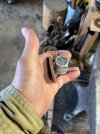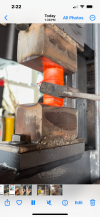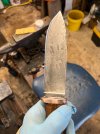-
The BladeForums.com 2024 Traditional Knife is available! Price is $250 ea (shipped within CONUS).
Order here: https://www.bladeforums.com/help/2024-traditional/
You are using an out of date browser. It may not display this or other websites correctly.
You should upgrade or use an alternative browser.
You should upgrade or use an alternative browser.
Canister damascus
- Thread starter H. M.
- Start date
Interesting concept, but I'm not sure the soot would hold in place sufficient while pouring the metal into canister to provide much protection. Why don't you try it and let us know? I've played around with paint/ss foil, but usually tend to just grind the canister off after welding up. I use 1/8" (or slightly less) metal for canister and by the time all the scale is removed after several forging heats there's not all that much canister left to grind off.Hi Has anyone heard of using acetyline soot to coat the insides of a canister ,instead of using white paint/white out or ss foil ? Thanks HM
Stacy E. Apelt - Bladesmith
ilmarinen - MODERATOR
Moderator
Knifemaker / Craftsman / Service Provider
- Joined
- Aug 20, 2004
- Messages
- 38,263
Soot is carbon. Carbon aids bonding in making damascus I would think it would make the canister stick even tighter.
Just make the canister up with no extra stuff beyond the steel and powder. Weld it solid and then draw it out. Grind the very thi layer of low-carbon canister steel off once drawn out.
Just make the canister up with no extra stuff beyond the steel and powder. Weld it solid and then draw it out. Grind the very thi layer of low-carbon canister steel off once drawn out.
- Joined
- Feb 24, 2000
- Messages
- 1,921
In my experience, it is not necessary to try to remove the canister. By the time the billet is forged out the canister is paper thin. Also if my understanding of carbon migration is correct the canister will have the same carbon content as the contents.
Stacy E. Apelt - Bladesmith
ilmarinen - MODERATOR
Moderator
Knifemaker / Craftsman / Service Provider
- Joined
- Aug 20, 2004
- Messages
- 38,263
Exactly what I tell people. You will remove whatever is left in the cleanup and shaping. Only need to grind is for re-stacking or folding.
Stacy E. Apelt - Bladesmith
ilmarinen - MODERATOR
Moderator
Knifemaker / Craftsman / Service Provider
- Joined
- Aug 20, 2004
- Messages
- 38,263
Hmmm, I never thought of doing mokume in a canister, but sounds very interesting. I always used a foil pouch and torque plates. Do you clamp it hard and weld it up and treat it just like regular a billet from there?
- Joined
- May 3, 2022
- Messages
- 121
I use a Zinzer paint primer. Works a good as white out. I’ve also used milk of magnesia as a release.
I have some bed frame angle iron that’s carbon steel but that has a coating of paint on it so that would either need to be stripped or left as is and peel the can.
So far I have always removed the canister so I can examine it for any flaws before I proceed.
I have some bed frame angle iron that’s carbon steel but that has a coating of paint on it so that would either need to be stripped or left as is and peel the can.
So far I have always removed the canister so I can examine it for any flaws before I proceed.
Stacy E. Apelt - Bladesmith
ilmarinen - MODERATOR
Moderator
Knifemaker / Craftsman / Service Provider
- Joined
- Aug 20, 2004
- Messages
- 38,263
My take (and many others) is that as long as the canister is on you are compacting the billet with the least chance of flaws. Remove it and oxidation and contamination will start to affect the billet.
YesHmmm, I never thought of doing mokume in a canister, but sounds very interesting. I always used a foil pouch and torque plates. Do you clamp it hard and weld it up and treat it just like regular a billet from there?
- Joined
- May 3, 2022
- Messages
- 121
I’ve played with Mokume of a stack of quarters to use for guards and pommels.
I’ve had the most success filling a sheet metal tube with the coins , wiring to hold the dimension and then crimping the ends over to contain the coins.
I’ve had the most success filling a sheet metal tube with the coins , wiring to hold the dimension and then crimping the ends over to contain the coins.
Attachments
- Joined
- Jul 27, 2003
- Messages
- 5,686
"Paint" the inside with anti-scale. It'll contaminate the barrier so it won't weld.



